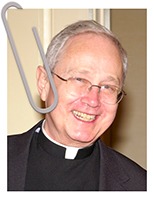How far can you see?
For a six-foot-tall person, the horizon is a little more than 3 miles away. On Mount Everest , the horizon is about 230 miles away.
The crew of Apollo 17 allowed us to see ourselves from 18,000 miles. I am still trying to wrap my thoughts around the Webb telescope allowing us to ” see” objects 28 BILLION light years away.
We see so little of God’s creation! Yet we still think of our world as the center of creation, our culture as the model for all cultures.
We still tend to see ourselves, our countries, and time as the center of the universe and history.
Using a science fiction parable, this Vincentian Mindwalk explores the vastness of God’s creation to provide perspective on our past and present.
Imagining future possibilities – a parable
In the tradition of Star Trek and Star Wars, let’s imagine a future when we might come face to face with intelligent life forms who think themselves superior to us.
These super-evolved time-travelers observe our life forms. But we matter little to them since they have superior intelligence. We are merely part of the flora and fauna. So they decide to “colonize” this speck we call home and use it for their own purposes.
They use it for their own purposes. In the process, they take our land, relegate us to “reservations,” and take steps to wipe out our culture. Some, with sincere good intentions, might try to “educate” us. They put us in residential schools to learn how to be like them.
This is not a pretty picture. They are oblivious to our suffering and pain. Yet they see themselves as the center of the universe.
Past as prologue
Now for some actual history!
Indigenous people have inhabited present-day Canada for thousands of years. Then, Europeans, mainly from France and England, arrived in the 1500s.
Pope Nicholas V promulgated the “Doctrine of Discovery” in 1455. It claimed that land was nothing until ‘discovered’, named, and occupied by Christians.
Between the mid-fifteenth century and the mid-twentieth century, this idea allowed European entities to seize lands inhabited by indigenous peoples under the guise of “discovering new land” not inhabited by Christians
While the doctrine of discovery might be considered obsolete by some, it continues to have implications today for Indigenous communities. For example, since 1823 it has been used by the U.S. Supreme Court to deny Indigenous Peoples’ land petitions.
Back to the Present
Canadian Archbishop Lavoie, a close friend of the St. Vincent DePaul Society in Canada, writes
… trauma is not about what happened to us – it is about what happens inside us as a result of what happened to us. Part of that trauma is the isolation of victims who can’t talk about what happened to them, and to thousands of other victims of that trauma.
The feeling I have is that we are on the cusp of a huge learning curve, just beginning to wake up to the magnitude of the trauma inflicted upon generations of Indigenous by the colonial residential school system.
“All of us, as Church, now need healing: healing from the temptation of closing in on ourselves, of defending the institution rather than seeking the truth, of preferring worldly power to serving the Gospel,”
In times past, Jesus cried out, “Let those who have ears hear.” He still calls out today. Today Jesus still calls out, “Let those who have ears hear.”
How far can we see and deeply hear?
Do we have ears to hear our brothers and sisters, not only in Canada but also in many other parts of our world?
Click below for an early version of this Vincentian Mindwalk


Explainer: Could Pope Francis revoke the 15th-century ‘Doctrine of Discovery’ used to justify colonizing Indigenous peoples?
https://www.americamagazine.org/politics-society/2022/07/28/dontrine-discovery-pope-francis-243435
Father, it’s a difficult balancing act to compare what might have been good with the missionary efforts promulgated by Pope Nicholas V (thanks for giving us that specific point to reckon from) and all the horrors that have surfaced in recent times, not just in Canada but throughout the world. So much of our continent (including Hawaii) would be completely different without that misguided direction from the papacy. We have inflicted so much harm in the name of righteousness.
I have read lately that the surviving leaders of those Indigenous Groups have blasted the apologies of both the Canadian governing officials and Pope Francis as being totally inadequate. Many are calling for reparation to the tune of hundreds of million dollars to be paid to those nations of people. My aversion to litigation kicks in here, but I sympathise with their point.
Your parable is excellent. But, we also need to focus on whether remorse can ever lead to being forgiven. I fear that even more generations will need to pass before that will be possible, both in our domestic Church and in the Church Universal. For me, the most discouraging thing about both “Star Wars” and “Star Trek” is that their vision of the future still depicts our default reaction to meeting new civilizations as waging wars with those we disagree with, whether we understand their culture or not, or violent “civil” wars that cause ultimate destruction
When we were kids, the Catechism and other sources encouraged us to be the Church Militant. Perhaps, now is the time to take off the armor and put on aprons and say, “We’re sorry. Please allow us to work side by side with you to restore your identity and respect in the vast land which we now share.”
That’s a difficult challenge on a personal level too. We have our “private little wars” as the old Joe Wise folk hymn, “Lord, Teach Us to Pray” reminded us. I wish we had better choices to leave for those who come after us.
Here’s Joe Wise’s rendering of the hymn:
https://www.youtube.com/watch?v=gLcDdRdCGuc
The lyrics provided by the OSB community:
https://sbm.osb.org/2019/04/09/lord-teach-us-to-pray/